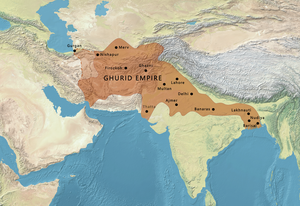
Back غوريون Arabic Qurilər Azerbaijani قوریلر AZB Ғуриҙар Bashkir Гурыды Byelorussian ঘুরি সাম্রাজ্য Bengali/Bangla Gúrides Catalan Dinastiyang Gurida CEB Ghuriden German Γκουρίδες Greek
Ghurid dynasty | |||||||||||||||||||||||
|---|---|---|---|---|---|---|---|---|---|---|---|---|---|---|---|---|---|---|---|---|---|---|---|
| 786–1215 | |||||||||||||||||||||||
| Capital | Firozkoh[9] Herat[10] Ghazni (1170s–1215)[11] | ||||||||||||||||||||||
| Common languages | Persian (court, literature)[12][13] | ||||||||||||||||||||||
| Religion | Before 1011: Paganism[14] From 1011: Sunni Islam[15] | ||||||||||||||||||||||
| Government | Hereditary monarchy Diarchy (1173-1206) | ||||||||||||||||||||||
| Malik/Sultan | |||||||||||||||||||||||
• 8th-century | Amir Banji (first) | ||||||||||||||||||||||
• 1214–1215 | Zia al-Din Ali (last) | ||||||||||||||||||||||
| History | |||||||||||||||||||||||
• Established | 786 | ||||||||||||||||||||||
• Disestablished | 1215 | ||||||||||||||||||||||
| Area | |||||||||||||||||||||||
| 1200 est.[16] | 2,000,000 km2 (770,000 sq mi) | ||||||||||||||||||||||
| |||||||||||||||||||||||
The Ghurid dynasty (also spelled Ghorids; Persian: دودمان غوریان, romanized: Dudmân-e Ğurīyân; self-designation: شنسبانی, Šansabānī) was a Persianate dynasty of presumably eastern Iranian Tajik origin, which ruled from the 8th-century in the region of Ghor, and became an Empire from 1175 to 1215.[17] The Ghurids were centered in the hills of the Ghor region in the present-day central Afghanistan, where they initially started out as local chiefs. They gradually converted to Sunni Islam after the conquest of Ghor by the Ghaznavid ruler Mahmud of Ghazni in 1011. The Ghurids eventually overran the Ghaznavids when Muhammad of Ghor seized Lahore and expelled the Ghaznavids from their last stronghold.
The Ghurids initially ruled as vassals of the Ghaznavids and later of the Seljuks. However, during the early twelfth century the long-standing rivalry between the Seljuks and Ghaznavids created a power vacuum in eastern Afghanistan and Panjab which the Ghurids took advantage of and began their territorial expansion. Ala al-Din Husayn ended the Ghurid subordination to the Ghaznavids, ruthlessly sacking their capital, although he was soon defeated by the Seljuks after he stopped paying tribute to them. The Seljuk imperial power, however, was itself swept away in eastern Iran with the contemporaneous advent of the Khwarazmian Empire.
During the dyarchy of Ala al-Din Husayn nephews - Ghiyath al-Din Muhammad and Muhammad of Ghor, the Ghurid empire reached its greatest territorial extent, holding encompassed territory from eastern Iran through easternmost India. While Ghiyath al-Din was occupied with the Ghurid expansion in the west, his junior partner in the dyarchy, Muhammad of Ghor and his lieutenants were active east of the Indus Valley as far as Bengal and eventually succeeded in conquering wide swaths of the Gangetic Plain, while in the west under Ghiyath al-Din, engaging in a protracted duel with the Shahs of Khwarazm, the Ghurids, reached as far as Gorgan (present-day Iran) on the shoreline of the Caspian Sea, albeit for a short time.
Ghiyath al-Din Muhammad died in 1203 of illness caused due to rheumatic disorders and soon after the Ghurids suffered a crushing defeat against the Khwrezmians aided by timely reinforcements from the Qara Khitais in the Battle of Andkhud in 1204. Muhammad was assassinated soon after in March 1206 which ended the Ghurid influence in Khurasan. The dynasty became extinguished all together within a decade when Shah Muhammad II uprooted the Ghurids in 1215. Their conquests in the Indian Subcontinent nevertheless survived for several centuries under the evolving Delhi Sultanate established by Qutb ud-Din Aibak.
- ^ Schwartzberg, Joseph E. (1978). A Historical Atlas of South Asia. Oxford University Press, Digital South Asia Library. p. 147, Map "g".
- ^ Eaton 2019, p. 38.
- ^ Bosworth, C.E. (1 January 1998). History of Civilizations of Central Asia. UNESCO. pp. 432–433. ISBN 978-92-3-103467-1.
- ^ Thomas 2018, p. 26, Figure I:2.
- ^ Schmidt, Karl J. (20 May 2015). An Atlas and Survey of South Asian History. Routledge. p. 37, Map 16.2. ISBN 978-1-317-47681-8.
- ^ History of Civilizations of Central Asia. UNESCO. 1 January 1998. ISBN 978-92-3-103467-1.
In 1201 Ghurid troops entered Khurasan and captured Nishapur, Merv, Sarakhs and Tus, reaching as far as Gurgan and Bistam. Kuhistan, a stronghold of the Ismailis, was plundered and all Khurasan was brought temporarily under Ghurid control
- ^ Bosworth 2001b.
- ^ Turkish History and Culture in India: Identity, Art and Transregional Connections. BRILL. 17 August 2020. p. 237. ISBN 978-90-04-43736-4.
In 1205, Bakhtīyar Khilji sacked Nudiya, the pre-eminent city of western Bengal and established an Islamic government at Laukhnauti, the capital of the predecessor Sena dynasty. On this occasion, commemorative coins were struck in gold and silver in the name of Muhammad b. Sām
- ^ Auer 2021, p. 6.
- ^ Firuzkuh: the summer capital of the Ghurids Archived 6 April 2012 at the Wayback Machine, by David Thomas, pg. 18.
- ^ The Grove Encyclopedia of Islamic Art & Architecture: Three-volume set, by Jonathan Bloom, Sheila Blair, pg. 108.
- ^ The Development of Persian Culture under the Early Ghaznavids, C.E. Bosworth, Iran, Vol. 6, (1968), 35;;"Like the Ghaznavids whom they supplanted, the Ghurids had their court poets, and these wrote in Persian"
- ^ O'Neal 2015.
- ^ Minorsky, Vladmir (1970). Ḥudūd al-'Ālam, "The Regions of the World,". Leningrad: University Press, Oxford. p. 110. ISBN 9780906094037.
- ^ The Ghurids, K.A. Nizami, History of Civilizations of Central Asia, Vol.4, Part 1, ed. M.S. Asimov and C.E. Bosworth, (Motilal Banarsidass Publishers, 1999), 178.
- ^ Bang, Peter Fibiger; Bayly, C. A.; Scheidel, Walter (2 December 2020). The Oxford World History of Empire: Volume One: The Imperial Experience. Oxford University Press. pp. 92–94. ISBN 978-0-19-977311-4.
- ^ Barisitz, Stephan (28 April 2017). Central Asia and the Silk Road: Economic Rise and Decline over Several Millennia. Springer. p. 94. ISBN 978-3-319-51213-6.
